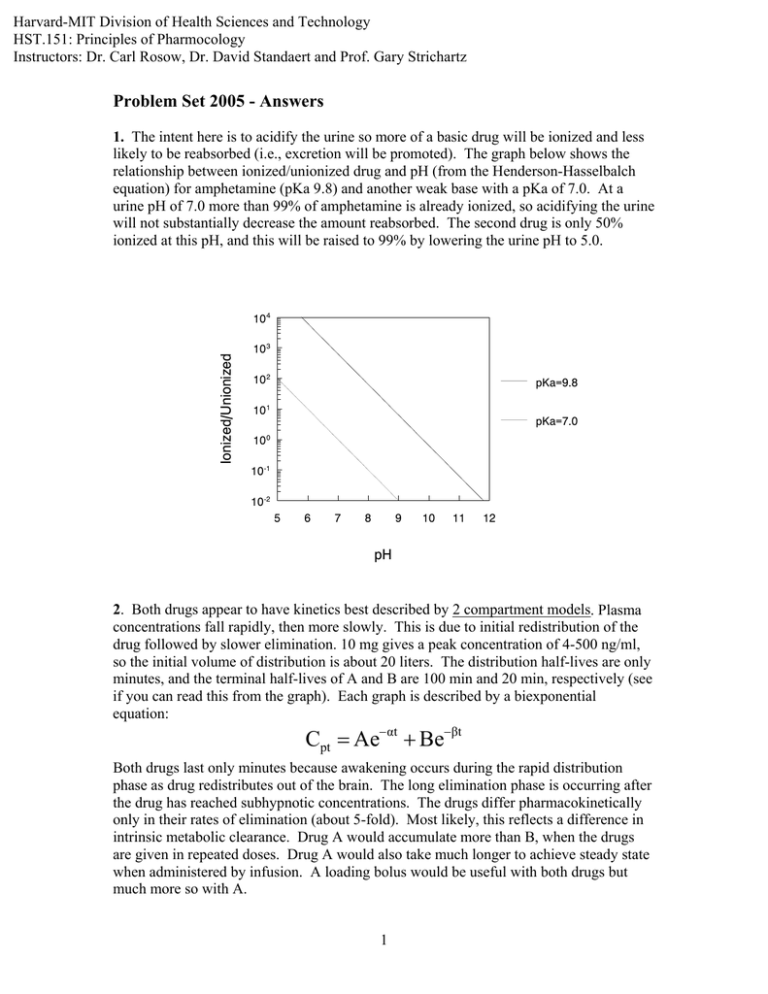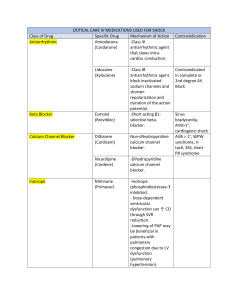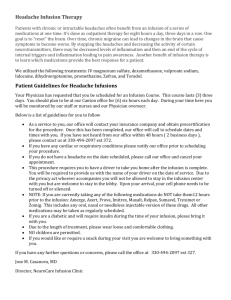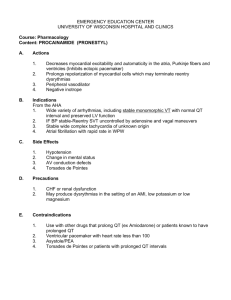Harvard-MIT Division of Health Sciences and Technology HST.151: Principles of Pharmocology
advertisement

Harvard-MIT Division of Health Sciences and Technology HST.151: Principles of Pharmocology Instructors: Dr. Carl Rosow, Dr. David Standaert and Prof. Gary Strichartz Problem Set 2005 - Answers 1. The intent here is to acidify the urine so more of a basic drug will be ionized and less likely to be reabsorbed (i.e., excretion will be promoted). The graph below shows the relationship between ionized/unionized drug and pH (from the Henderson-Hasselbalch equation) for amphetamine (pKa 9.8) and another weak base with a pKa of 7.0. At a urine pH of 7.0 more than 99% of amphetamine is already ionized, so acidifying the urine will not substantially decrease the amount reabsorbed. The second drug is only 50% ionized at this pH, and this will be raised to 99% by lowering the urine pH to 5.0. Ionized/Unionized 10|4 10|3 10|2 pKa=9.8 10|1 pKa=7.0 10 |0 10|-1 10|-2 5 6 7 8 9 10 11 12 pH 2. Both drugs appear to have kinetics best described by 2 compartment models. Plasma concentrations fall rapidly, then more slowly. This is due to initial redistribution of the drug followed by slower elimination. 10 mg gives a peak concentration of 4-500 ng/ml, so the initial volume of distribution is about 20 liters. The distribution half-lives are only minutes, and the terminal half-lives of A and B are 100 min and 20 min, respectively (see if you can read this from the graph). Each graph is described by a biexponential equation: Cpt = Ae−αt + Be−βt Both drugs last only minutes because awakening occurs during the rapid distribution phase as drug redistributes out of the brain. The long elimination phase is occurring after the drug has reached subhypnotic concentrations. The drugs differ pharmacokinetically only in their rates of elimination (about 5-fold). Most likely, this reflects a difference in intrinsic metabolic clearance. Drug A would accumulate more than B, when the drugs are given in repeated doses. Drug A would also take much longer to achieve steady state when administered by infusion. A loading bolus would be useful with both drugs but much more so with A. 1 3. The partial agonist pindolol, given alone, would have weak β agonist activity. Since it has greater affinity for the β receptor than NE and other full agonists, it can act as a competitive antagonist. Even after high doses, the blockade will never be complete, since pindolol possesses some intrinsic β agonist activity. Supposedly, β antagonists with intrinsic sympathomimetic properties are less likely to cause bradycardia, bronchoconstriction, and lipid abnormalities. The evidence for this is not very strong. 4. It requires 10 times as much naloxone to block the effects of the peptide. The most likely explanation is that the peptide and morphine are interacting with different receptors. In fact, this type of experimental data is used as evidence for different receptor mechanisms (see Strichartz lecture). Sensitivity to the antagonist is sometimes expressed as “pA2,” the negative logarithm of the concentration causing 50% reduction in effect. Also possible: different allosteric sites on the same receptor. 5. The concentration at time 0 (C0 = 80 ng/ml) and the half-life (10 hr) may be read from the graph Concentration (ng/ml) 100 10 1 0 10 20 30 40 50 60 Hours • • Dose 16mg = = 200 Liters ng C0 80 ml ln2 0.7 k= = = 0.07 hr −1 t 1/2 10 hr Vol Dist = • Cl = k ⋅ Vd = 0.07 hr −1 ⋅ 200 Liters = 14 L/hr = 233 ml/min • C ss = infusion rate 0.04 mg/min = = 172 ng/ml Cl 233 ml/min C ss = infusion doubled 0.08 mg/min = = 344 ng/ml Cl 233 ml/min Time to steady-state is 4-5 half-lives in either case. 2 70 80 • Loading dose should be given for rapid treatment of arrhythmia, and infusion for maintenance of effect. Therapeutic window is 100-500 ng/ml, so the acceptable range of loading doses and infusion rates may be calculated: Loading Dose = Vd ⋅ C Threshold = 200 Liters ⋅ 100 ng/ml = 20 mg Loading Dose = Vd ⋅ C Toxic = 200 Liters ⋅ 500 ng/ml = 100 mg Infusion = Cl ⋅ C Threshold = 233 ml/min ⋅ 100 ng/ml = 23.3 µg/min Infusion = Cl ⋅ C Toxic = 233 ml/min ⋅ 500 ng/ml = 116.5 µg/min 6. You would measure the binding of increasing amounts of a labeled β1 ligand like dobutamine in both myocardial samples. Since the remaining receptors are normal in the CHF tissue, the Scatchard plot would show no change in slope (-1/kD is unchanged), but the intercept would be decreased (R0 is 50% normal). 7. The effect of warfarin on the intrinsic pathway is measured by the prothrombin time or INR. Warfarin prevents the activation of vitamin K by blocking the reduction of the epoxide to the active hydroquinone. Active vit K is needed for γ carboxylation of factors VII, IX, X, and II. Reversal of warfarin can be achieved by a. stopping the drug temporarily b. administering vitamin K c. giving fresh frozen plasma which contains preformed clotting factors 3 An important issue here is the absence of actual bleeding. You probably would not use treatments b or c unless she were bleeding or had a high likelihood of bleeding (e.g., needed surgery). Just as warfarin has risks and benefits, so do the treatments. Giving vitamin K will make reestablishing anticoagulation difficult and unpredictable for many days (she was probably taking warfarin for a good reason). Giving fresh frozen plasma will expose her to the risks of infection and allergy. 8. A non-selective α blocker like phentolamine will also block presynaptic α2 receptors that mediate feedback inhibition of NE release. It will therefore increase the NE released and produce more β sympathetic effects like tachycardia. A selective α1 blocker like prazosin is less likely to cause this effect. Inhibition of insulin release is also mediated by α2 receptors, so phentolamine is more likely to cause hypoglycemia. 9. A non-selective β1/β2 blocker like propranolol increases the risk of hypoglycemia in diabetics because it impairs lipolysis, glycogenolysis, and gluconeogenesis. It may also block tachycardia that is often an early sign of an insulin reaction. Blockade of β2 receptors in a patient with COPD may aggravate bronchospasm, although the risk of this is often overstated. 10. Ephedrine is an indirect-acting sympathomimetic which acts by blocking the vesicle membrane associated transporter and displacing preformed neurotransmitter from storage granules in the adrenergic nerve terminal. • Reserpine will deplete the granules, so ephedrine will have less effect. • Pargyline will inhibit MAO in the presynaptic terminal so increased amounts of NE will be available for release (i.e., the hypertensive effect will be exaggerated). Over the long term, this potentiation may become smaller because pargyline will allow the accumulation of octopamine, a relatively inactive “false transmitter,” in the nerve ending. • Repeated administration of ephedrine eventually will have a decreasing effect, because it depletes granules and causes “tachyphylaxis.” 11. The patient is hypotensive and tachycardic, and the history of trauma and blood loss suggests hypovolemic shock. Of course, she needs blood and other fluids, and she may need surgery to stop the bleeding. While these measures are instituted, you would probably treat her BP with a peripheral vasoconstrictor (i.e. an α1 agonist like phenylephrine or possibly the mixed agonist, norepinephrine). In this instance, the high pulse rate is almost certainly a reflex response to the low blood pressure, and you would not want to give a β blocker like propranolol to slow her down (this will drop her cardiac output even further). There is nothing in the history to suggest myocardial injury or decreased contractility, so an inotrope like the β1 agonist, dobutamine, is not indicated. 12. A transplanted heart has no cardioaccelerator fibers (T1-4) and no vagal innervation, so one would not expect effects from drugs that act by modulating nerve activity. Specifically, an anticholinergic like atropine will have no effect on heart rate.. The heart rate and contractile state will still respond relatively normally to direct acting sympathomimetics like norepinephrine and isoproterenol. 4




